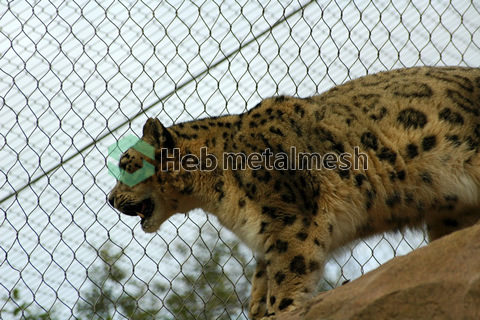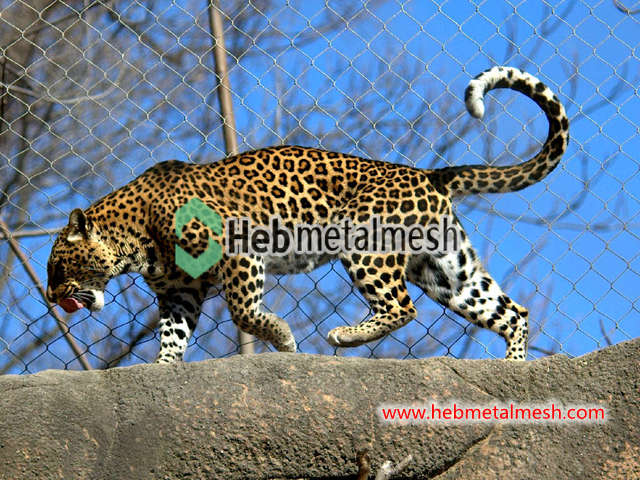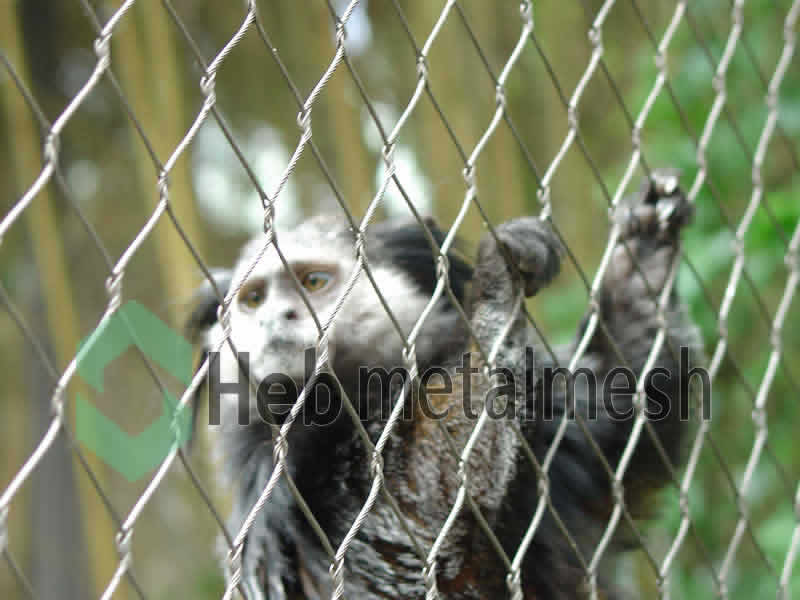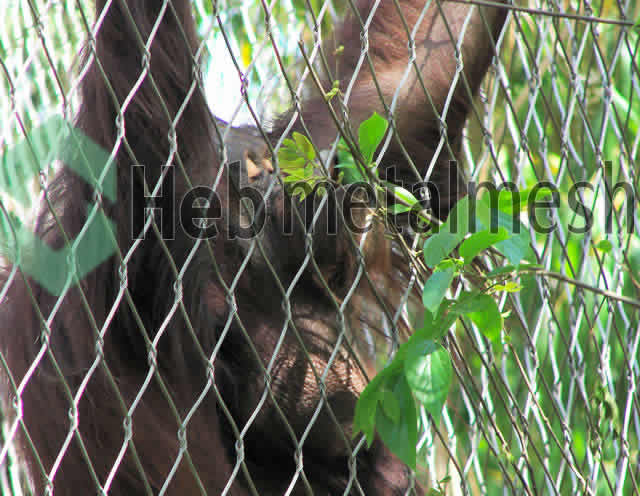Understanding Wildlife Fences
✅Choose a best specification and size for wildlife fences for leopard enclosure.
✅Contact for your customized panel size and need.
✅Goto leopard enclosure mesh page to understand more.
Wildlife fences are specially designed barriers that play a critical role in the conservation and protection of various animal species, including leopards. These fences are not mere enclosures; they integrate safety measures for both the animals and their surrounding habitats. Their fundamental purpose is to mitigate human-wildlife conflict, facilitate habitat preservation, and ensure the welfare of wildlife within designated areas.
There are several types of wildlife fencing, each suited for specific needs and environments. One common type is the enclosure, which is often utilized in wildlife reserves and sanctuaries. These enclosures aim to provide a safe haven for leopards while allowing for natural behaviors to occur. Exhibits are another type, often found in zoos or educational settings, which offer public viewing while maintaining the animals’ well-being through secure barriers. Pens are smaller fenced areas typically used for rehabilitation or breeding purposes, ensuring that vulnerable species can thrive in a controlled environment.
The importance of wildlife fences extends beyond merely keeping animals in or out. They play a fundamental role in sustaining biodiversity and protecting ecosystems by preventing leopards from straying into human-populated areas where they may face dangers, such as poaching or vehicle collisions. Furthermore, these barriers can inhibit invasive species, thereby supporting native flora and fauna. Properly designed and maintained wildlife fencing systems are vital to achieving human-wildlife coexistence, allowing both leopards and surrounding communities to flourish.
In summary, understanding wildlife fences is essential for comprehending their significance in conservation efforts for species like leopards. The variety of fencing types serves to protect both the animals and their natural environments, highlighting the importance of integrating effective wildlife management strategies in various ecosystems.
The Importance of Safety in Wildlife Fencing
When it comes to the preservation and management of wildlife, particularly with formidable species like leopards, the selection and implementation of effective wildlife fences are crucial. Safety stands at the forefront of this process, as both human and animal welfare must be carefully considered. Wildlife fences serve a dual purpose: they not only contain animals within designated areas but also protect them from external threats, thereby maintaining ecological balance. This necessitates adherence to various safety standards and regulations that guard against escapes and injuries.
One of the primary aspects of constructing wildlife fences for leopards is ensuring that the materials and structure are formidable enough to withstand the strength and agility of these big cats. Typically, leveraging high-tensile strength materials can effectively deter leopards from breaching a fence. Moreover, the height of the fence is a critical factor; it must be tall enough to prevent the leopards from jumping over. Regulations may stipulate a minimum height, often exceeding six or seven feet, depending on local wildlife laws.
In addition to physical barriers, wildlife fencing should incorporate elements designed to reduce stress for the animals confined within. For instance, the design must allow leopards to display natural behaviors without feeling cornered or threatened. The inclusion of natural vegetation along the perimeter can provide shade and shelter, thereby creating a more comfortable environment for the leopards. Furthermore, it is important that the fencing does not inhibit the animal’s ability to interact positively with their habitat.
Implementing wildlife fences aligned with recognized safety standards not only promotes the well-being of leopards but also supports their conservation. By fostering secure spaces where leopards can thrive, experts can enhance their chances of survival in an increasingly fragmented ecosystem. Ensuring that wildlife fences meet these essential criteria is a vital step in the ongoing effort to protect these magnificent creatures.
Choosing the Right Material for Wildlife Fences
When it comes to constructing effective wildlife fences, selecting the right material is paramount. Various materials can be utilized, but some stand out due to their safety, durability, and aesthetic appeal. One such material gaining prominence is stainless steel rope mesh. This fencing solution not only addresses the practical concerns of keeping wildlife secure but also integrates well into diverse environmental landscapes.
Stainless steel rope mesh is particularly beneficial because it exhibits remarkable strength and resilience. Unlike traditional options like wooden or barbed wire fences, stainless steel does not corrode, which ensures longevity even in challenging weather conditions. Additionally, its strength makes it capable of withstanding attempts from larger animals, such as leopards, to cross over or break through. The design of the mesh allows visibility while providing a robust barrier, thus maintaining the natural beauty of the surroundings.
Another advantage of stainless steel rope mesh is its flexibility. It can be adapted to different terrains and landscapes with minimal alterations, ensuring a suitable fit for various environments where wildlife fences are needed. Comparatively, plastic or composite materials may lack the durability required for long-term use, particularly in areas frequented by robust wildlife.
Furthermore, stainless steel rope mesh aligns with conservation principles, making it an environmentally friendly choice. It minimizes the impact on the landscape while promoting wildlife safety. In contrast, traditional fence materials can be intrusive and potentially harmful to habitats. This fencing option enhances not only the safety of wildlife but also the aesthetic aspect of the properties it encloses.
In conclusion, the choice of material for wildlife fences plays a critical role in ensuring safety and durability. Stainless steel rope mesh emerges as a superior option due to its strength, flexibility, and minimal environmental impact, making it an ideal solution for those looking to protect both wildlife and their property.
Designing Effective Leopard Enclosures
Creating effective enclosures for leopards requires careful consideration of several critical factors, as these majestic creatures exhibit both strength and agility. One of the primary aspects of designing a leopard enclosure is the height of the wildlife fences. Leopards are excellent climbers, with the ability to scale trees and other structures swiftly. Therefore, the minimum recommended height for enclosures is generally around 12 feet. This prevents escape while also ensuring the enclosures are designed with features that indicate security and avoid potential conflict between the animal and its surroundings.
Moreover, the strength of the wildlife fences is paramount in creating a secure environment. Materials used should be robust enough to withstand the physical capabilities of leopards. Chain-link fencing combined with solid panels can be effective, as it provides visibility while also blocking potential distractions that may disturb the animal. Reinforcements at the bottom and along the sides can prevent digging or climbing, further enhancing the security of the enclosure.
Accessibility and visibility are also significant design considerations. Creating an enclosure that allows for clear viewing by the public while ensuring the leopards feel secure is essential. Transparent mesh panels or glass can be integrated at certain points to provide unobstructed views without compromising the animals’ sense of safety. Additionally, habitat enrichment is crucial in maintaining a healthy environment for leopards. This involves introducing natural elements like logs, rocks, and vegetation, which not only mimics their wild habitat but also stimulates their natural behaviors, such as climbing, stalking, and hiding.
By thoughtfully considering these factors, zoos and wildlife parks can create enclosures that not only meet the necessary safety standards but also enhance the overall experience for both leopards and visitors alike.
Exhibit vs. Pen: Understanding the Differences
When it comes to housing leopards, understanding the distinction between wildlife exhibits and pens is crucial for providing an appropriate environment. Wildlife exhibits are typically expansive, designed to mimic a natural habitat and allow for a varied landscape where leopards can engage in their instinctual behaviors. These environments often include trees, rocks, and water features, catering to the needs of the animals by promoting exploration and interaction with their surroundings. Exhibits are commonly utilized in zoos or wildlife parks, where the primary goal is education and observation by the public.
In contrast, wildlife pens are more confined spaces that are generally intended for specific purposes such as rehabilitation, breeding, or temporary holding. They usually offer less complexity compared to exhibits and may consist of simple fencing structures that ensure the safety of the animal and the caretakers. The size of a pen is often smaller, leading to more limited opportunities for the leopard to engage in its natural behaviors. These facilities are crucial for care during routines such as veterinary check-ups or recovery from injury.
When selecting between a wildlife exhibit and a pen for leopards, one must consider several factors, including purpose, available space, and resources. Exhibits require a significant investment in land, design, and maintenance but provide an enriched environment conducive to long-term resident health. On the other hand, pens are more cost-effective and suitable for short-term use or specific management needs in wildlife care. Ultimately, the choice depends on the institution’s objectives and the welfare of the leopards involved. Understanding the fundamental differences helps ensure that these majestic animals receive the care and environment they need to thrive.
Installation Tips for Wildlife Fences
Installing wildlife fences, particularly those designed to protect leopard habitats, requires careful planning and execution. The first step in the installation process is site preparation, which involves assessing the geographical and environmental conditions of the area. It is crucial to survey the land for any existing vegetation and wildlife trails, as well as possible obstructions such as rocks or trees that may hinder the installation of the fencing materials.
Once the site has been evaluated, the next phase involves strategic layout planning. The design of the wildlife fence should account for the natural movement patterns of leopards, ensuring that the fence does not disrupt their habitat or behavior unnecessarily. Consideration should be given to the height and strength of the fence, as leopards are known to be agile climbers and jumpers. Therefore, ensuring that the fence is tall enough and reinforced appropriately is essential. A height of at least eight feet is recommended for effective wildlife management.
After finalizing the layout, it is time to begin the installation process of wildlife fences, specifically if you are using stainless steel rope mesh. Begin by marking the perimeter based on the planned layout. The installation typically starts from one corner and progresses systematically to ensure alignment. Use durable materials to secure the posts and ensure they are buried deep enough to withstand the pressure from wildlife. The stainless steel rope mesh should be tensioned properly to avoid sagging, providing both security and visibility. Connecting it tightly to the posts will create a deterrent barrier that effectively keeps leopards and other wildlife from breaching the fence.
In order to enhance the installation, it is advisable to seek assistance from experienced wildlife management professionals, as they can provide insights and tips based on best practices and local conditions. Proper installation guarantees that the wildlife fence serves its purpose effectively, maintaining the delicate balance between wildlife protection and habitat preservation.
Maintenance of Wildlife Fences
Proper maintenance of wildlife fences is critical to ensuring their longevity and effectiveness in protecting both wildlife and human habitats. Routine inspections play a vital role in identifying any potential damage or wear that could compromise the fence’s purpose. When it comes to stainless steel rope mesh, which is commonly used due to its strength and durability, regular maintenance is particularly important. This type of wildlife fence is designed to withstand the elements, but it is not impervious to wear and tear over time.
One best practice is to conduct comprehensive inspections at least twice a year. During these inspections, look for signs of corrosion, structural integrity issues, or wildlife intrusion. If any gaps or weaknesses are identified, immediate repairs should be made. Using the right tools and materials is essential; for instance, stainless steel fasteners and repair kits should be on hand to maintain the integrity of the wildlife fences. Additionally, ensure that the supporting posts are firmly anchored to prevent leaning or collapse, which can easily occur due to weather conditions or animal interactions.
Cleaning the fence is also a crucial aspect of its maintenance. Over time, dirt, debris, and vegetation can accumulate around the fence, obstructing visibility and possibly compromising its function. A simple wash with water and a soft brush can remove accumulated debris while ensuring that the stainless steel maintains its aesthetic appeal. Moreover, consider utilizing a protective coating on the mesh to prevent rust and enhance durability.
By adhering to these maintenance routines, wildlife fences can serve their purpose effectively, protecting both wildlife and human interests for many years. Implementing a proactive maintenance schedule not only preserves the physical structure of the fence but also aids in monitoring wildlife behavior, ensuring that the fencing remains an effective barrier against unwanted human-wildlife interactions.
Case Studies: Successful Leopard Enclosures
Effective wildlife fences play a crucial role in creating safe environments for leopards, particularly in areas where human-wildlife conflict is prevalent. Various case studies have demonstrated the effectiveness of different fencing designs specifically tailored for these majestic predators. One notable example is the use of stainless steel rope mesh, which has proven to be a robust solution for enclosures. This material not only provides excellent visibility for both the animals and visitors but also resists corrosion and requires minimal maintenance.
In a case study conducted in a wildlife sanctuary in South Africa, the adoption of stainless steel rope mesh fencing was implemented to contain leopards without obstructing the natural landscape. The fence stood at a strategic height of 2.5 meters, significantly reducing the likelihood of leopards jumping over. Additionally, the mesh’s flexibility allowed for adaptation to the geographical features of the land, such as uneven terrain and vegetation. Initial challenges included concerns over the durability of the material. However, extensive testing under various environmental conditions confirmed its longevity and resilience.
Another exemplary case occurred in a nature reserve in India, where conservationists sought to implement wildlife fences as a means to deter leopards from entering neighboring farmland. The reserve installed an electrified stainless steel mesh, ensuring both effectiveness and safety. This design not only prevented leopards from breaching the boundaries but also minimized the risk of electrocuting non-target species. The project faced initial objections from local communities, highlighting the importance of involving stakeholders in the planning phases. In response, education programs emphasized the benefits of wildlife fences, successfully garnering public support.
These case studies illustrate the varied approaches to building effective leopard enclosures using wildlife fences. They emphasize the significance of selecting appropriate materials, such as stainless steel rope mesh, as well as engaging with local communities to mitigate human-wildlife conflicts.
Conclusion: Making the Right Choice for Wildlife Fencing

In conclusion, selecting the appropriate wildlife fencing is crucial for maintaining the safety of both wildlife and human populations, particularly in areas where leopards and other large animals roam. Throughout this guide, we have explored several important aspects of wildlife fencing, emphasizing the significance of choosing a design that meets the specific needs of the surrounding ecosystem while ensuring minimal ecological disruption.
One of the standout options discussed is the use of stainless steel rope mesh. This material offers strength and durability, making it highly effective in containing wildlife such as leopards without obstructing their natural movements or behaviors. The use of stainless steel not only enhances security but also reduces the likelihood of wear and environmental degradation over time, making it an excellent long-term investment for wildlife management.


